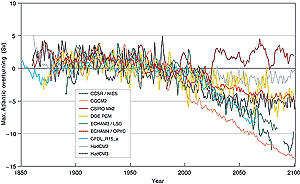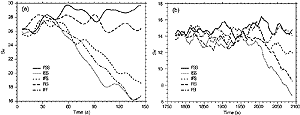9.3.4.3 Thermohaline circulation changes

Figure 9.21: Simulated water-volume transport change of the Atlantic
“conveyor belt” (Atlantic overturning) in a range of global warming
scenarios computed by different climate research centres. Shown is the annual
mean relative to the mean of the years (1961 to 1990) (Unit: SV, 106
m3s-1). The past forcings are only due to greenhouse
gases and aerosols. The future-forcing scenario is the IS92a scenario. See
Table 9.1 for more information on the individual
models used here. |
In the SAR, it was noted that the thermohaline circulation
(THC) weakens as CO2 increases in the atmosphere in most coupled climate model
integrations. The weakening of the THC is found in both the Northern and Southern
Hemispheres. The amount of weakening varied from model to model, but in some
cases it was noted that the THC in the North Atlantic stopped completely (Manabe
and Stouffer, 1994; Hirst 1999). The weakening of the THC in the Atlantic Ocean
results in a reduction of the poleward heat transport that in turn leads to
a minimum in the surface warming in the northern North Atlantic Ocean and/or
in the circumpolar Ocean (see Section 9.3.2). The reduction
in the warming in the North Atlantic region touches the extreme north-eastern
part of North America and north-west Europe. The shutting off of the THC in
either hemisphere could have long-term implications for climate. However, even
in models where the THC weakens, there is still a warming over Europe. For example,
in all AOGCM integrations where the radiative forcing is increasing, the sign
of the temperature change over north-west Europe is positive (see Figure
9.10).
Figure 9.21 shows a comparison of the strength of the
THC through a number of transient experiments with various models and warming
scenarios over the 21st century. The initial (control state) absolute strength
of the Atlantic thermohaline circulation (THC) varies by more than a factor
of 2 between the models, ranging from 10 to 30 Sv (1 Sv = 106 m3s-1).
The cause of this wide variation is unclear, but it must involve the sub-grid
parametrization schemes used for mixing in the oceans (Bryan, 1987) and differences
in the changes of the surface fluxes. The sensitivity of the THC to changes
in the radiative forcing is also quite different between the models. Generally
as the radiative forcing increases, most models show a reduction of THC. However,
some models show only a small weakening of the THC and one model (ECHAM4/OPYC;
Latif et al., 2000) has no weakening in response to increasing greenhouse gases,
as does the NCAR CSM as documented by Gent (2001). The exact reasons for the
difference in the THC responses are unknown, but the role of the surface fluxes
is certainly part of the reasons for the differences in the response (see below).
Stocker and Schmittner (1997), using an intermediate complexity model, found
that the North Atlantic THC shut-down when the rate of 1%/yr of CO2 increase
was held fixed for approximately 100 years. This is in agreement with the earlier
AOGCM study of Manabe and Stouffer (1994), where the THC shut-down in an integration
where the CO2 concentration increased by 1%/yr to four times its initial value.
In integrations where the CO2 stabilised at doubling, the THC did not shut-down
in either study (Stocker and Schmittner 1997; Manabe and Stouffer 1994). Furthermore,
in the Manabe and Stouffer (1994) AOGCM where the CO2 is stabilised at four
times its normal value, the THC recovers to the control integration value around
model year 2300. A recent study (Stouffer and Manabe, 1999) found that the amount
of weakening of the THC by the time of CO2 doubling is a function of the rate
of CO2 increase and not the absolute increase in the radiative forcing. They
found the slower the rate of increase, the more the weakening of the THC by
the time of CO2 doubling.

Figure 9.22: Time-series of the zonally integrated Atlantic mass
transport stream function at 30°N and 1500 m depth, close to the maximum
of the stream function simulated by the (a) ECHAM3/LSG model and the (b)
GFDL_R15_b model. For a description of the experiments see Table
9.5. |
The evolution of the THC in response to future forcing
scenarios is a topic requiring further study. It should be noted in particular
that these climate model experiments do not currently include the possible effects
of significant freshwater input arising from changes in land ice sheets (Greenland
and Antarctic ice caps) and mountain glaciers, which might well lead to bigger
reductions in the THC. It is too early to say with confidence whether irreversible
shut-down of the THC is likely or not, or at what threshold it might occur.
Though no AOGCM to date has shown a shut-down of the THC by the year 2100, climate
changes over that period may increase the likelihood during subsequent centuries,
though this is scenario-dependent. The realism of the representation of oceanic
mechanisms involved in the THC changes also needs to be carefully evaluated
in the models.
Role of the surface fluxes
The role of heat, fresh water and momentum fluxes in weakening the North Atlantic
THC as a consequence of increasing atmospheric CO2 concentration has been studied
in two different AOGCMs (ECHAM3/LSG, Mikolajewicz and Voss, 2000; and GFDL_R15_b,
Dixon et al., 1999). In both these studies (Figure 9.22),
two baseline integrations are performed; a control integration in which the
CO2 is held fixed, and a perturbation integration in which the CO2 is increasing.
The water fluxes from both of these integrations are archived and used as input
in two new integrations.
In the first integration, the atmospheric CO2 concentration is held fixed and
the fresh water fluxes into the ocean are prescribed as those obtained from
the perturbation integration. In the second integration, the CO2 increases as
in the perturbation integration and the water fluxes are prescribed to be the
fluxes from the control integration (see Table 9.5). In
this way, the relative roles of the fresh water and heat fluxes can be evaluated
(Figure 9.22).
| Table 9.5: The THC-sensitivity experiments. |
 |
|
Experiment
|
CO2 concentration
|
Freshwater flux
|
Wind stress
|
 |
|
FSS
|
fixed present day |
simulated |
simulated |
|
ISS
|
increasing |
simulated |
simulated |
|
IFS
|
increasing |
from FSS |
simulated |
|
FIS
|
fixed present day |
from ISS |
simulated |
|
FSI
|
fixed present day |
simulated |
from ISS |
|
IFF
|
increasing |
from FSS |
from ISS |
 |

